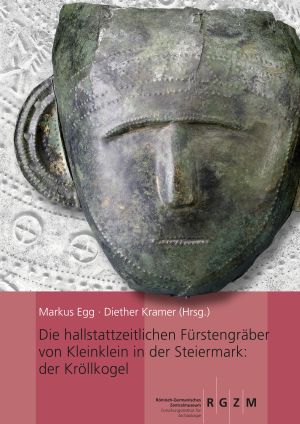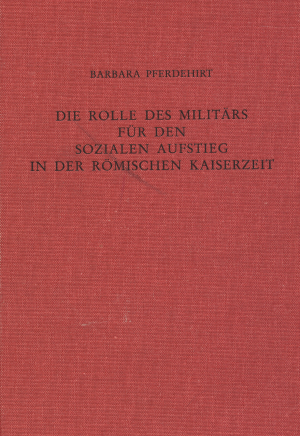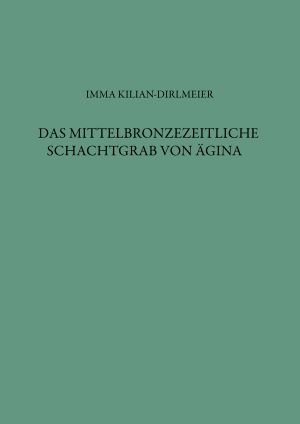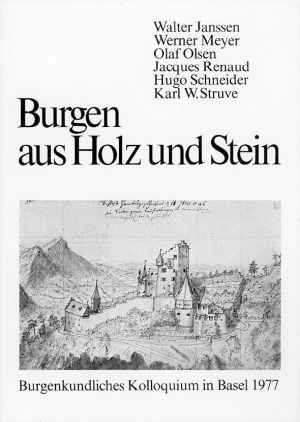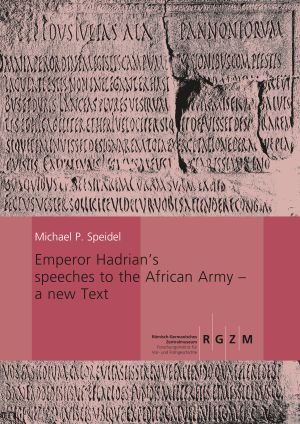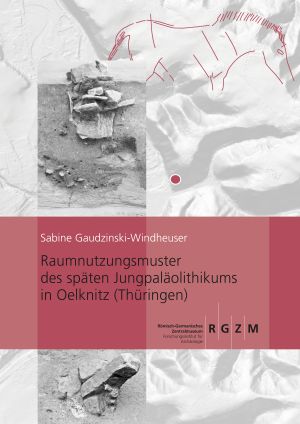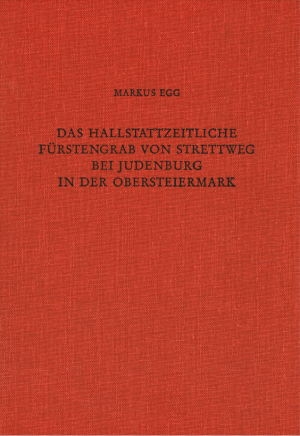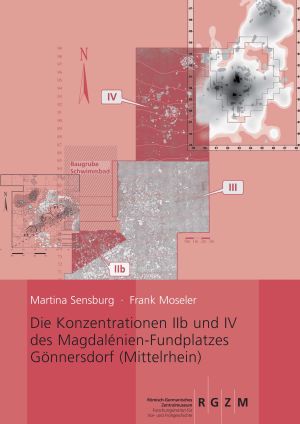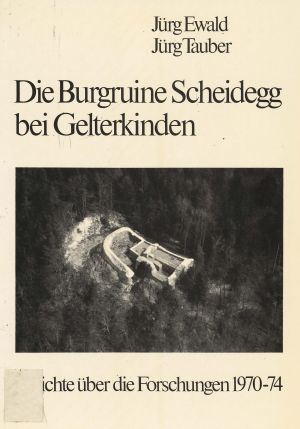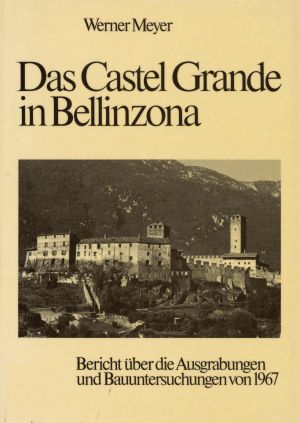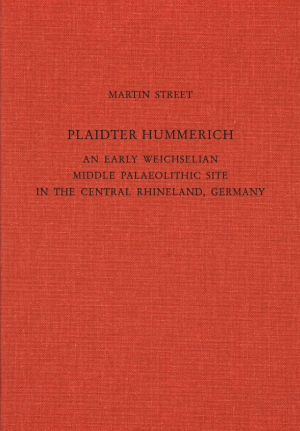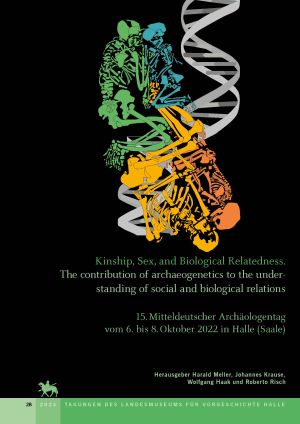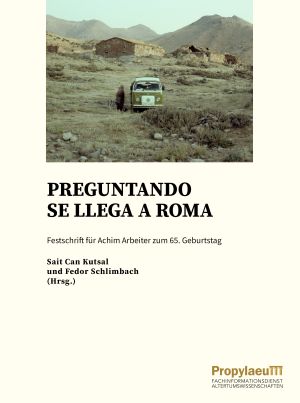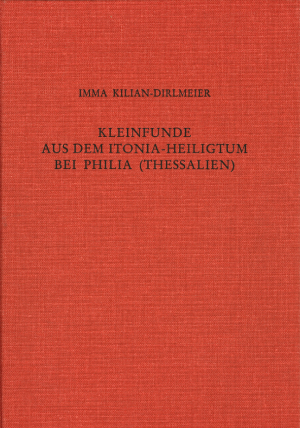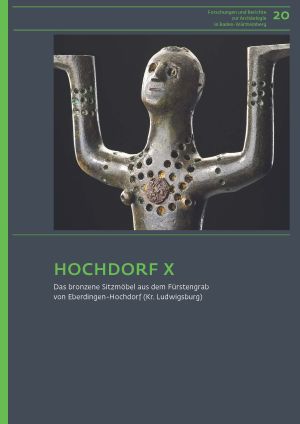Bücher
Römischer Basaltlava-Abbau zwischen Eifel und Rhein
Zwischen den Städten Andernach am Rhein und Mayen in der Eifel bestand bereits in der Antike eines der großen Abbaureviere für mineralische Rohstoffe. Produkte aus Basaltlava – allen voran qualitätvolle Mühlsteine – entwickelten sich in römischer Zeit zu regelrechten Exportschlagern. Über den Rhein im großen Stil verhandelt, fanden sie ihre Abnehmer in Britannien ebenso wie im Voralpenland.
Im Mittelpunkt der Untersuchung stehen die Mühlsteinbrüche am Bellerberg-Vulkan bei Mayen. Neue Ausgrabungen und Prospektionen im Rahmen des Vulkanpark Osteifel-Projektes ermöglichen eine detaillierte Rekonstruktion der Produktionsabläufe und zeigen eine hochgradige Arbeitsteilung. Modellrechnungen unter Einbeziehung aller Funde und Befunde auch aus vor- und nachrömischen Epochen erlauben Quantifizierungen der ökonomischen Prozesse. Eine Synthese aller vergleichbaren Abbaureviere in der Alten Welt rundet die Studie ab.
Das Siedlungsmuster des Mittelpaläolithikums in Süddeutschland: Eine GIS-gestützte Archäoprognose für Fundstellen in Bayern und Baden-Württemberg
Die vorliegende Studie untersucht das Siedlungsverhalten und die Raumnutzung des Neandertalers anhand der Lageparameter von mittelpaläolithischen Höhlen- und Freilandstationen in Süddeutschland. Methodisch arbeitet die Autorin mit dem "Weighted Layer Approach" (WLA) – einer Variante der multiplen linearen Regression. In das Modell gehen u.a. die Höhe über Normalnull, die Hangneigung, die Ausrichtung und die Distanz zum nächsten Fließgewässer ein. Diese Parameter werden mit geologischen Faktoren wie z.B. der Verbreitung pleistozäner Böden, dem Vorkommen eines Kalksteingebirges mit Höhlen und der Ausdehnung der pleistozänen Eisvorstöße in Beziehung gesetzt. Aus den transparent gewichteten Daten errechnet Wiesner ein Archäoprognose-Modell, das in detaillierte Prognosekarten für die Wahrscheinlichkeit des Vorhandenseins bislang noch unentdeckter mittelpaläolithischer Fundstellen im untersuchten Raum mündet. Die Arbeit wurde 2021 von der DGUF mit dem Deutschen Studienpreis für Archäologie ausgezeichnet.
Die hallstattzeitlichen Fürstengräber von Kleinklein in der Steiermark: der Kröllkogel
Die Fundstellen rund um den Burgstallkogel zwischen Großklein und Gleinstätten in der Weststeiermark zählen zu den herausragendsten der älteren Eisenzeit Österreichs und Mitteleuropas. Das Zentrum bildet die Höhensiedlung am Burgstallkogel, zu dessen Füßen sich die Sulmtal-Nekropole mit heute noch ca. 700 Grabhügeln ausbreitet.
Deutlich von ihr abgesetzt fanden sich auf der ersten Flussterrasse des Saggautals bei Kleinklein die vier reichsten Fürstengräber des gesamten Osthallstattkreises. Die meisten Funde wurden bereits im 19. und beginnenden 20. Jahrhundert geborgen. Eine erfolgreiche Nachgrabung von 1995 im jüngsten Fürstengrab, dem sogenannten Kröllkogel, gab den Impuls zur vorliegenden Neubearbeitung und Neubewertung des Prunkgrabes. Um dieses Ziel zu erreichen, schlossen sich das Universalmuseum Joanneum in Graz und das RGZM zusammen und organisierten eine interdisziplinäre Forschergruppe, die alle Aspekte des Fundes untersuchte.
Die Rolle des Militärs für den sozialen Aufstieg in der römischen Kaiserzeit
Um im römischen Reich wichtige Ämter in Politik, Verwaltung und Militär übernehmen zu können war das römische Bürgerrecht unabdingbar. Peregrine Männer, die sich für den Militärdienst verpflichteten, erhielten nach Ablauf ihrer Dienstzeit und ehrenhafter Entlassung das römische Bürgerrecht für sich und ihre Kinder sowie das Recht mit einer Nichtrömerin eine rechtmäßige Ehe zu führen. Im vorliegenden Buch wird auf der Grundlage von sog. Militärdiplomen untersucht, wie sich diese Privilegien bei den verschiedenen Truppengattungen im Laufe der Zeit veränderten und welche Auswirkungen sich dabei für die Nachkommen der Soldaten ergaben.
Die Burg Zug: Archäologie – Baugeschichte – Restaurierung
Die Burg Zug hat in ihrer mehr als achthundertjährigen Geschichte ein wechselvolles Schicksal erlebt. Ein grosser Teil des heute noch erhaltenen Gebäudekomplexes wurde ab dem 12. Jh. als Herrschaftssitz erbaut, entwickelte sich seit dem Spätmittelalter zum Wohnhaus und erfuhr im 20. Jh. den Umbau in ein historisches Museum.
Zwischen 1967 und 1982 fanden auf dem Burgareal archäologische Ausgrabungen und im Burggebäude umfassende Bauuntersuchungen statt. Die Auswertung ergibt ein unerwartet detailreiches Bild der Geschichte dieses ausserordentlichen und über die Grenzen des Kantons Zug hinaus bedeutenden Gebäudes. Schwerpunkte der Veröffentlichung bilden die Vorstellung der Ergebnisse aus Ausgrabungen und Bauuntersuchungen sowie die Präsentation der archäologischen Funde. Im Weiteren werden aber auch die Restaurierung des Gebäudes und das Ausstellungskonzept des «Museums in der Burg» erläutert.
Dauerthal, Wallmow, Klockow, Dreesch, Rosow und Bietikow – verursacherfinanzierte Grabungen mit bandkeramischen Funden und Befunden aus der Uckermark, Brandenburg
In der Uckermark zeigten sich beim Abtrag von 1,5 Millionen qm Oberboden sechs Fundstellen mit bandkeramischen Befunden. Zwei Grubenhäuser belegen einen Haustyp mit Pfostenstellungen und Wandbewurf: einfache, überdachte Arbeitsbereiche, die bei der Schlachtung, Milchveredlung und Nahrungszubereitung in Garöfen genutzt wurden. Der Fundplatz Dauerthal lieferte ausschließlich Haustiere. Die Rinder wurden vor Ort geschlachtet, zerlegt und die Häute zu Leder verarbeitet. Das Fehlen bestimmter Körperteile ist auffällig und wird interpretiert. Es liegen keine Pfostenstellungen von Langhäusern vor, anderenorts ein Charakterbefund dieser Kultur. Die Keramik zeigt keine Unterschiede zu den Nachbarräumen, der Kontakt zu den indigenen Jägern-und-Sammlern ist über Trapeze und schrägendretuschierte Klingen belegt.
Solutré: An archeozoological analysis of the Magdalenian horizon
In dieser Monographie werden die Ergebnisse einer Analyse der Fauna des magdalénischen Horizonts von Solutré, Burgund, Frankreich, vorgestellt. Sie zeigen, dass die Magdalener in Solutré hauptsächlich Pferde jagten, aber auch relativ viele Rentiere und Bisons erbeuteten. Die Todeszeitpunkte von Pferden, Rentieren und Bisons deuten darauf hin, dass der Ort wahrscheinlich zu unterschiedlichen Jahreszeiten genutzt wurde und dass Gruppen junger Rentiere und Bisons saisonal erlegt wurden. Eines der charakteristischen Merkmale der magdalénischen Faunengruppe ist die äußerst geringe Anzahl von Schlachtspuren und die große Anzahl von Nagespuren von Fleischfressern an den Überresten von Pferden, Rentieren und Bisons.
Das mittelbronzezeitliche Schachtgrab von Ägina
In ihrer strategisch günstigen Position in der Mitte des Saronischen Golfs hat die Insel Ägina über Jahrtausende eine bedeutende Rolle im Verkehrsnetz der Ägäis gespielt. Das 1982 bei Plangrabungen in der befestigten Siedlung auf Kap Kolonna freigelegte Grab ist ein signifikantes Zeugnis für diese Bedeutung in der mittleren Bronzezeit. Archäologisch sichtbar ist das im Beigabenreichtum, der Grabarchitektur und der topographischen Lage. Vergleichbare Elitebestattungen kommen auf dem griechischen Festland und auf vorgelagerten Inseln vor. Mit der Analyse der Bestattungssitten eröffnen sich neue Perspektiven auf soziale Struktur, Verkehrsnetze und Etablierung einer machtausübenden Führungsschicht.
Burgen aus Holz und Stein: Burgenkundliches Kolloquium in Basel 1977
Die Publikation ist der Tagungsband eines burgenkundlichen Kolloquiums, welches 1977 in Basel anlässlich des 50. Geburtstags des Schweizerischen Burgenvereins durchgeführt wurde. In der Rückschau auf ein halbes Jahrhundert SBV, der auch im Ausland einen guten wissenschaftlichen Ruf geniesst, wurde der thematische Rahmen bewusst weit gefächert. Die Beiträge aus dem In- und Ausland weisen auf die Vielfalt des mittelalterlichen Wehrbaues hinsichtlich Funktion, Form und Material hin. Die sechs Vorträge verbindet ein wichtiges thematische Leitmotiv der derzeitigen Mittelalterforschung: die Eingliederung archäologischer Befunde in historische Zusammenhänge. Die beiden Schweizer Beträge: Hugo Schneider leuchtet in seinem Aufsatz über die Letzimauern (Letzinen=Sperranlagen oder Grenzbezeichnungen) im Alpenraum in die Entstehungszeit der Eidgenossenschaft hinein, während Werner Mayer versucht, über die Zusammenhänge von Burgenbau, Herrschaftsbildung und Rodungstätigkeit (Rodungsherrschaft) einen archäologischen Beitrag zur mittelalterlichen Siedungsgeschichte zu liefern. Walter Janssen zeigt anhand der Niederungsburgen im Rheinland den Übergang vom Holzbau zur Steinarchitektur im Hochmittelalter auf und untersucht die gesellschaftliche Stellung einzelner Adelsgeschlechter aufgrund archäologischer Unterschiede im Burgenbau. Ähnlich wie Jacques Renaud über die niederländischen Backsteinburgen des 13./14. Jh., in denen sich die Geschichte des niederländischen Feudalismus spiegelt. Aus der geographischen Lage und Bauweise der Holzburgen der Slawen in Nordwestdeutschland geht Karl Struve der sozialen Struktur der slawischen Stämme nach. Die geometrischen Ringwallfestungen (Ringburgen) der Wikingerburgen in Dänemark geben im Beitrag von Olaf Olsen Einblick in die militärische und politische Organisation des dänischen Königtums zur Zeit der Wikinger.
Emperor Hadrian’s speeches to the African Army – a new text
Im Sommer 128 begab sich Kaiser Hadrian (117-139) nach Numidien, um die Kampffähigkeiten der afrikanischen Armee Roms zu überprüfen. In Reden an die Truppen bewertete er die Manöver, deren Zeuge er wurde. Anschließend hielt die Armee die Reden in einer Inschrift auf dem Exerzierplatz in Lambaesis fest. Obwohl diese Reden gekürzt und durch Lücken unterbrochen wurden, sind sie die einzigen erhaltenen Reden eines antiken Kaisers an seine Soldaten und bieten daher einen einzigartigen Einblick in die Ausbildung und die Kampffähigkeiten der römischen Armee.
Das Ziel dieses Buches ist es, so viel wie möglich von Hadrians Reden wiederherzustellen, die Struktur der Inschrift wiederherzustellen und einen kohärenten Text zu schaffen, damit Hadrians Worte durch die Jahrtausende hindurch wieder erklingen können.
Raumnutzungsmuster des späten Jungpaläolithikums in Oelknitz (Thüringen)
In Diskussionen zur Evolution menschlichen Verhaltens spielt die Frage danach, wie sich Menschen im Raum bewegt haben, eine entscheidende Rolle. Die frühesten Hinweise auf Verhaltensmuster, die in diesem Sinne interpretiert werden können, stammen vom Übergang vom Mittel- zum Jungpaläolithikum.
Die thüringische Fundstelle Oelknitz repräsentiert eines der wichtigsten Zeugnisse früher Gesellschaftssysteme, die bereits vor ca. 15000 Jahren sichtbar werden. Die Analyse dieses Platzes vermag es, ob der weltweiten Spärlichkeit solcher exzellent überlieferten Befunde, die Variabilität von Siedlungssystemen im späten Jungpaläolithikum aufzuzeigen und zu einem weitaus vielschichtigeren Verständnis des Siedlungswesens beizutragen.
Das hallstattzeitliche Fürstengrab von Strettweg bei Judenburg in der Obersteiermark
Strettweg in der Obersteiermark war 1851/52 Schauplatz einer der bedeutendsten archäologischen Entdeckungen Österreichs. Das reich ausgestattete Prunkgrab aus der Eisenzeit (um 600 v. Chr.) enthielt neben vielen anderen Gegenständen den berühmten "Kultwagen" – ein einzigartiges Meisterwerk hallstattzeitlichen Kunsthandwerks.
Die reichen Metallbeigaben sind Waffen, Pferdegeschirr- und Wagenteile, Bronze- und Tongefäße – also klassische Prestigegüter hallstattzeitlicher Eliten. Grabbeigaben der weiblichen Tracht lassen auf Totenopfer schließen. Weitreichende Kulturkontakte in die Hallstatt-Kulturen nördlich der Alpen, nach Oberitalien sowie in die antike Welt lassen sich nachweisen.
Das Erdwerk der Michelsberger Kultur von Bruchsal „Aue“: Eine lange Geschichte
Am nordöstlichen Rand des badischen Städtchens Bruchsal wurde 1986 im Gewann „Aue“ durch Luftbildbefliegung ein Doppelgrabenwerk der Michelsberger Kultur (etwa 4300–3600 v. Chr.) entdeckt. In den Jahren 1987–1993 konnten die noch auf etwa 550 m Länge erhaltenen Gräben annähernd vollständig archäologisch untersucht werden. Überraschend war die Auffindung von sechs Grabgruben am Rande und unter der Sohle des äußeren Grabens mit den Skeletten von neun Kindern und sieben Erwachsenen in teils geordneter, teils irregulärer Lage.
Die sorgfältig dokumentierte Ausgrabung machte es möglich, die Baugeschichte der Grabenanlage detailliert nachzuvollziehen. Die Analyse der Befunde offenbarte, dass das Erdwerk zu keiner Zeit in der heute erhaltenen Gestalt existierte, sondern dass diese das Ergebnis vielfältiger anthropogener und natürlicher Umformungen über einen Zeitraum von sechs Jahrhunderten hinweg ist. Die Diskussion um die Funktion der Michelsberger Erdwerke kann allerdings auch in Bruchsal „Aue“ nicht entschieden werden – Hinweise auf eine profane Siedlungsnutzung mit Defensivcharakter sind ebenso vorhanden wie auf kultisch-rituelle Handlungen.
Die bronze- und früheisenzeitlichen Troiafunde der SammlungHeinrich-Schliemann im Römisch-Germanischen Zentralmuseum
Bei den im vorliegenden Band publizierten Troiafunden handelt es sich, abgesehen von Gipskopien verschiedener Keramiken, um so genannte Dubletten, also Zwillingsstücke von Keramiken und Kleinfunden aus dem Bestand der Berliner Museen, die im Zuge der Abschlussinventarisierung in den Jahren 1895-1900 an 35 europäische Museen und Forschungsinstitute vergeben wurden, um die Kernsammlung in Berlin besser zu gliedern und übersichtlicher zu gestalten. Die Mainzer Troiasammlung besteht aus teils fragmentierter, teils in den Werkstätten des Forschungsinstituts restaurierter Keramik der Besiedlungsphasen Troia I bis VIIb2, also der Schichten der frühen Bronze- bis frühen Eisenzeit nach anatolischer Terminologie. Der Bestand an Kleinfunden umfasst Objekte aus Ton, Stein und Muschelkalk.
»Die bronze- und früheisenzeitlichen Troiafunde der Sammlung Heinrich Schliemann im Römisch-Germanischen Zentralmuseum« versteht sich als zeitgemäßer Beitrag zur Aufarbeitung des gewaltigen, bislang nur ansatzweise kritisch gewürdigten archäologischen Erbes Heinrich Schliemanns.
Die Konzentrationen IIb und IV des Magdalénien-Fundplatzes Gönnersdorf (Mittelrhein)
Der Magdalénien-Fundplatz Gönnersdorf bietet aufgrund seines Fundreichtums und der außergewöhnlich guten Erhaltung einzigartige Möglichkeiten der räumlichen Analyse eines jungpaläolithischen Siedlungsareals. Während die Konzentration IV bereits Gegenstand einer 1997 erschienenen Untersuchung war, handelt es sich bei Konzentration IIb um eine bislang unerforschte Siedlungsstruktur.
Die Konzentration IIb stellt eine Teilfläche der Großkonzentration II dar, deren zentrale Siedlungsstruktur (Konzentration IIa) bereits 2007 ausführlich behandelt wurde (Monogr. RGZM 69). Im Vordergrund steht nun, die Funktion der Siedlungsstrukturen in Konzentration IIb zu klären sowie ihr zeitliches und räumliches Verhältnisses zu den benachbarten Konzentrationen IIa und III.
Eine erneute räumliche Analyse von Konzentration IV erschien sinnvoll, da sich besonders digitale Analyseverfahren seit der Erstbearbeitung erheblich verfeinert haben, und nun einige vormals unbehandelte Teilaspekte untersucht werden konnten. Das führte hinsichtlich der Beziehung zwischen latenten und evidenten Befunden sowie der Artefaktherstellung in K–IV zu detaillierten Ergebnissen.
Einheit in der Vielfalt? Zur Kulturpflanzennutzung im Byzantinischen Reich unter besonderer Berücksichtigung archäobotanischer Untersuchungen in Caričin Grad (Justiniana Prima)
Pflanzen haben große Bedeutung im menschlichen Alltag, sie dienen nicht nur als Nahrungslieferanten, sondern auch als Roh- und Baustoffe, Brennstoffe oder Futtermittel für den Haustierbestand. Verschiedene Pflanzenspektren können daher Einblicke in das Alltagsleben der Menschen geben, deren kulturelle Vorlieben oder in die Umweltbedingungen. Die Studie befasst sich mit der Kulturpflanzennutzung im Byzantinischen Reich basierend auf archäobotanischen Daten und hat zwei grundlegende Schwerpunkte: zum einen die archäobotanische Analyse von Makroresten aus der frühbyzantinischen Stadt Caričin Grad in Südserbien, anhand derer die Ernährung der Stadtbevölkerung sowie landwirtschaftliche Praktiken rekonstruiert werden. Zum anderen wird ein literaturbasierter überregionaler und diachroner Überblick zur Kulturpflanzennutzung im Byzantinischen Reich (395–1453) gegeben. In der Auswertung auf regionaler Ebene werden charakteristische Merkmale der Kulturpflanzennutzung jeder Region und der jeweiligen Epochen vor dem historischen Hintergrund und den vorherrschenden Umweltbedingungen ausgearbeitet und anschließend in einen überregionalen und diachronen Überblick überführt.
Modelling Archaeological Landscapes: Bridging Past and Present in two Mediterranean Islands
Die wachsende Bedeutung von kulturellen (auch archäologischen) Landschaften hat die Archäologie in den letzten Jahren vor neue große Herausforderungen gestellt, denen man nur durch interdisziplinäre Zusammenarbeit und auf der Basis von partizipatorischen Initiativen begegnen kann. Die dringende Notwendigkeit, effektive Konzepte zur Erschließung von archäologischen Stätten und ihrer natürlichen Umgebung zu entwickeln, kann der Anlass sein, um die zerstörerischen Methoden der Archäologie mit kreativen Strategien zu erweitern und dadurch das Profil dieser Disziplin in Forschung und Lehre drastisch zu verändern. Diese Überlegungen standen im Vordergrund des vorliegenden Bandes, der die Ergebnisse des Projekts „Modelling Archaeological Landscapes. Bridging Past and Present in Two Mediterranean Islands“ vorstellt, welches von den Universitäten von Heidelberg und Catania im Jahr 2018 durchgeführt und vom DAAD (Deutscher Akademischer Austauschdienst) gefördert wurde.
Die Burgruine Scheidegg bei Gelterkinden: Bericht über die Forschungen 1970–74
Abseits der grossen Verkehrsströme liegt die Burgruine Scheidegg auf einem bewaldeten Höhenzug, hoch über der Gemeinde Tecknau im obersten Teil des Ergolztales. Unter der Leitung der Kantonsarchäologie Basel-Landschaft wurde die Ruine 1970–74 untersucht. Aufgrund der bestimmbaren Kleinfunde liegt die Entstehungszeit der Burg zwischen 1220 und 1230. Den Untergang fand sie um 1320 in einer (natürlichen) Brandkatastrophe. Das zeigt sich neben der mächtigen Brand- und Schuttschicht in einem Fundensemble, das alle Bereiche des Alltagslebens der Burgbewohner erfasst. Bemerkenswert ist das Auffinden von Skelettteilen von 7 Pferden, die vermutlich beim Brand elendiglich zu Grunde gingen. Architektonisch zeichnet sich die Burg durch einen grossen Wohnturm aus, der an den Ecken mit Rundpfeilern verstärkt war, und einen Burghof, in den eine mächtige Filterzisterne eingebaut war.
Das spätkeltische Wagengrab von Boé (Dép. Lot-et-Garonne): Studien zu Wagen und Wagengräbern der jüngeren Latènezeit
1959 wurde in Aquitanien beim Oppidum Agen ein Komplex entdeckt, der als reiches Grab identifiziert werden konnte; eine Nachgrabung von R. Boudet bestätigte dies 1990. Das Grab kann wohl einem rex der Nitiobrogen zugewiesen werden, der ca. 50-35 v. Chr beigesetzt wurde. Die Keramik umfasst Amphoren (Dressel 1B, Lamboglia 2), italische (u.a. Campana B) und einheimische Formen. Die Metallfunde sind außergewöhnlich reich. Ein vierrädriger Prunkwagen, dessen Konstruktion der von Dejbjerg ähnelt, konnte rekonstruiert werden. Wagen stellen seit der Bronzezeit wichtige Bestandteile reicher Gräber dar. Wagenfunde aus Latène C/D wurden für Mitteleuropa gesammelt und methodisch analysiert; die Gräber wurden in ihren Kontext eingeordnet.
Das Castel Grande in Bellinzona: Bericht über die Ausgrabungen und Banuntersuchungen von 1967
Die Talsperre von Bellinzona gehört zu den grossartigsten mittelalterlichen Wehranlagen der Schweiz. Immer wieder ist um den Besitz dieses festen Platzes gestritten worden. Hier dröhnte der Schritt des römischen Legionärs, hier zogen germanische und rätische Horden vorbei, hier versuchten die jeweiligen Herren Italiens, fremde Eindringlinge aufzuhalten. Erst als um 1500 Bellinzona an die Eidgenossen überging, kehrten ruhigere Zeiten ein, worauf die Festungswerke allmählich ihren militärischen Wert verloren.
Der vorliegende Bericht kann keinen Anspruch darauf erheben, eine vollständige Geschichte von Castel Grande zu bieten. Denn die Boden- und Bauuntersuchungen beschränkten sich infolge von Baumassnahmen auf den Südtrakt der Burg. Die Bodenuntersuchungen erbrachten Bauphasen vom 4. bis zum 11. Jh., die Untersuchungen an den Mauern zeigten Elemente von der 1. Hälfte des 13. Jh. bis zum Ende des 15. Jh. Die Kleinfunde machen eine prähistorische Besiedlung des Hügels wahrscheinlich und belegen eine Benützung von augusteischer Zeit bis in die Gegenwart. Das hochmittelalterliche Fundgut verrät deutlich Einflüsse aus dem nördlichen Alpenvorland (Ofenkacheln) und aus Italien (Majolika). Seit dem 13. Jh. verstärkt sich deutlich das lombardisch-italienische Element und findet im 15. Jh. den Höhepunkt; nicht nur im Fundgut, sondern in der baulichen Ausgestaltung der Wehranlage.
Plaidter Hummerich: an early Weichselian Middle Palaeolithic site in the Central Rhineland Germany
Der mittelpaläolithische Fundplatz Plaidter Hummerich lag auf dem Gipfel des namengebenden heute fast ganz abgebauten Osteifel-Vulkanes. Angrenzend im Osten ist die flache Landschaft des Neuwieder Beckens sowie das Rheintal. Ausgrabungen 1983-1986 der mehrschichtigen eiszeitlichen Ablagerungen der Kraterfüllung bargen etwa 3,000 Einzelfunde von Tierresten sowie 2,000 Funde aus lithischen Materialien. Letztere geben Einsicht in das technologische Können der Neandertaler, die verwendeten Gesteine weisen auf eine weiträumige Mobilität. Die Reste von überwiegend großen Pflanzenfressern – Wildrind, Pferd, Rothirsch – belegen das reichlich vorhandene Wildvorkommen als verfügbare Nahrungsbasis.
Kinship, Sex, and Biological Relatedness : The contribution of archaeogenetics to the understanding of social and biological relations. 15. Mitteldeutscher Archäologentag vom 6. bis 8. Oktober 2022 in Halle (Saale)
Zwischenmenschliche Beziehungen sind seit jeher die Grundlage gesellschaftlichen Zusammenlebens. Der Verwandtschaft – ob biologisch oder sozial – kommt dabei eine ganz besondere Bedeutung zu. In der Archäologie konnten diese immateriellen Verbindungen bisher nur selten zweifelsfrei nachgewiesen werden. Die Archäogenetik hat jedoch in den letzten Jahren Methoden und Verfahren entwickelt, die es bei guter DNA-Erhaltung erlauben, den Grad genetischer Nähe zwischen zwei Menschen zu bestimmen, die in der Vergangenheit gelebt haben.
Die hier gesammelten Beiträge schöpfen ihr Wissen zum Thema Verwandtschaft aus Anthropologie, Archäologie, Genetik sowie der Geschichts- und Sozialwissenschaft. Sie verdeutlichen anhand von aktuellen oder bereits bekannten Fundplätzen, welche Rückschlüsse die neuen naturwissenschaftlichen Erkenntnisse einerseits ermöglichen, zeigen andererseits aber auch deren Grenzen bei der Interpretation von (prä-)historischen Gesellschaften auf.
Preguntando se llega a Roma: Festschrift für Achim Arbeiter zum 65. Geburtstag
Der Band enthält fünfzehn Aufsätze von Schülern und (ehemaligen) Mitarbeitern Achim Arbeiters, der 2023 seinen 65. Geburtstag und zugleich auch sein 25-jähriges Jubiläum als Professor für ‚Christliche Archäologie und Byzantinische Kunstgeschichte‘ an der Georg-August-Universität Göttingen feiert. Die Beiträge befassen sich mit ikonographischen und ikonologischen Aspekten von Bildwerken, mit stilistischen, typologischen und ikonographischen Aspekten von Architektur, mit Siedlungsarchäologie, Musik, antiken Traditionen in christlichen Heiligenkulten und der mehrfachen Belegung von Gräbern. Chronologisch reichen die Studien von der Spätantike bis ins Mittelalter, geographisch führen sie von der Levante über Nordafrika, den Balkan und Italien bis auf die Iberische Halbinsel.
Kleinfunde aus dem Itonia-Heilgtum bei Philia (Thessalien)
Steinstelen mit Inschriften des thessalischen Koinon sichern die Lokalisierung des Itonia-Heilgtums, des Stammenheiligtums der Thessaler, beim Dorf Philia, Nomos Karditsa (Thessalien). Ab 1960 wurde das Areal des Heiligtums durch Tiefpflügen bis zum gewachsenen Boden aufgerissen und von Raubgräbern intensiv geplündert. Teile der Ausbeute sind in europäische und amerikanische Museen gelangt. Bei den systematischen Rettungsgrabungen 1963-67 konnte D. Theocharis nur noch geringe Reste von Stratigraphie und ungestörten Befunden dokumentieren. Die Bearbeitung der Kleinfunde konzentriert sich deshalb auf die chrono-typologische Bestimmung. Weiter werden die Funktionen – Votiv, Kultgerät, Werkzeug u.ä. – behandelt sowie die Frage nach dem Personenkreis der Besucher gestellt. Aussagen zum diachronen Verlauf des Kultbetriebs können sich auf die Funde und auf die literarische Überlieferung stützen.
Hochdorf X: Das bronzene Sitzmöbel aus dem Fürstengrab von Eberdingen-Hochdorf (Kr. Ludwigsburg)
Mehr als vier Jahrzehnte nach der Ausgrabung vollendet die Vorlage der in letzter Funktion als Totenliege genutzten Sitzbank die grundlegenden Publikationen zum Inventar des späthallstattzeitlichen Kammergrabes von Hochdorf (um 530 v. Chr.). Den Kern des vorliegenden Sammelbands bildet ein Katalog zum Gesamtbild des einzigartigen Möbelstücks, der auf digitalen bildgebenden Verfahren fußt. Um ihn gruppieren sich detaillierte Beschreibungen zu Befund, Bergung, Restaurierung und Fertigungstechnik, die in der Darstellung eines Nachbaus des Stückes schließen. Vertiefend treten textilarchäologische Analysen der reichen Anhaftungen auf der Totenliege hinzu. Einen weiteren Schwerpunkt stellen archäometallurgische Untersuchungen der Möbelteile sowie der eisernen Substruktion dar. Fragen nach der Herkunft des Objektes werden in einer kulturgeschichtlichen Studie zu seinen südalpinen und italischen Vorbildern und zur Interpretation des Bildprogramms diskutiert. Den Band beschließen bioarchäologische Beiträge zu dem Toten aus dem Zentralgrab sowie weiteren Bestattungen aus dem Hügelbereich.





